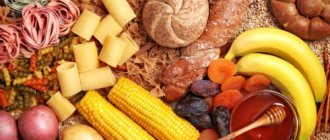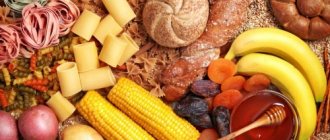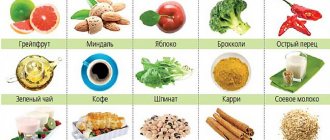What is the reason for thinness in teenagers?
During adolescence, the body grows and changes rapidly.
But few people think about how large-scale these metamorphoses are, and how much energy and “building material” are required for this.
Growth rates in adolescents can be quite rapid, because the body is actively developing. This applies to the skeleton, muscles and internal organs.
Let's add mental activity at school, passion for various sports - all this contributes to a huge expenditure of energy.
In such conditions, gaining or maintaining normal weight becomes a difficult task.
Read also[edit | edit code]
- Metabolism in children and adolescents
- Nutritional assessment of child athletes
- Proper diet for child athletes
- Menus and diets for children athletes
- Nutrition and control of body composition and weight
- Diets for children involved in sports
- Sports nutrition for children
- Sports nutrition for children and teenagers
- Vitamin and mineral complexes for children
- Diet for gaining muscle mass
Nutrition before training - Post-workout nutrition How to increase appetite
- Protein-carbohydrate alternation
How to determine your weight norm
There are many tables for determining optimal body weight. Moreover, different countries have adopted their own standards for the same height.
For example, in the USA, a man with a height of 180 cm has a recommended weight of 75 kg. And for us, for the same 180 cm – 85 kg.
There are tables with weight standards for children, adolescents, men and women.
As a rule, adolescents have body weight standards that are several kilograms less than adults of the same sex.
The simplest test to determine optimal weight:
Weight should be equal to height, without the first digit.
For example, your height is 175 cm. This means your weight should be 75 kg. Body weight deviations in both directions are allowed by 3-5 kg.
But it must be said that this is very relative, because everything depends not only on height, but also on the percentage of fat and muscle mass. Therefore, body weight is too arbitrary an indicator.
Proper nutrition
Let's first answer two popular questions from adults:
“If my child is thin, then maybe he should be fed more fatty and high-calorie foods: sweets, muffins, fast food and sweet cola?”
Of course not! No matter what weight your child has, the diet should be healthy.
“Is a child’s diet different from an adult’s?”
No, all healthy foods that adults eat can be eaten by children from the age of five. And middle-aged and older children consume approximately the same portions as adults.
The UK Department of Health advises feeding thin children according to the Eatwell Guide. By the way, this diet is not one bit different from the one that British doctors advise adults. So write it down for yourself and for your children.
Proper nutrition should consist of five different categories. No matter what kind of diet you or your child is on, a healthy diet is sure to contain all five components. But within one component you can choose what to eat and what to abstain from.
The first component is fruits, vegetables, berries
We've all heard that we need to eat vegetables and fruits every day. And we all do not follow this rule, but in vain.
Fruits and vegetables should make up one third of the daily diet of a child and an adult. You should eat five servings of fruits and vegetables per day. How much is it?
For adults and children of middle and older age, one serving is:
– 1 fruit or vegetable the size of an apple/tomato
or
– 2 kiwis / 2 plums / 2 figs / 3 apricots / 3 prunes / 7 strawberries / 14 cherries / 1 tablespoon raisins
or
– an apple-sized slice from any large fruit or berry such as watermelon
or
– 1 glass of freshly squeezed juice.
Fruits and vegetables can be consumed in different forms:
- Fresh fruits and vegetables are the best option;
- Boiled vegetables, for example, boiled carrots;
- Frozen and canned fruits, vegetables and berries. This is especially true in northern countries in winter;
- Freshly squeezed unsweetened juice.
Potatoes and all legumes (peas, beans, lentils, chickpeas, etc.) are among the other ingredients, which we will talk about below!
Second component
– foods high in carbohydrates. They also make up a third of the total amount of food consumed, in other words, the child should eat about the same amount of them as fruits and vegetables.
So what does this include? First of all:
- potato;
- bread and other cereal products;
- all kinds of cereals;
- rice;
- pasta.
Each of the above products has its own beneficial microelements and vitamins, so it is better that all these products are present in the diet, for example, by day of the week.
Third component
– high protein foods. They should make up a sixth of the daily menu. What this includes: fish and meat, eggs, legumes (peas, beans, lentils, chickpeas, etc.).
Fourth component
- dairy products. They can be consumed a little less than protein: milk, cheese, animal fats in small quantities, Greek (i.e. unsweetened) yogurt.
Fifth component
– vegetable and butter. The best vegetable oil is olive oil, but coconut, sunflower and other types of oils are suitable. It does not need to be consumed in large quantities, but you should not forget about the oil. Butter is a natural source of fat, which is also necessary for every child and adult.
An additional source of fat for thin children will be nuts (almonds, peanuts), corn and fish - the best source of animal fats.
How strictly should the components be followed?
There is absolutely no need to calculate an even ratio of food intake.
In addition, there is no need to necessarily consume each component daily. For example, if your child did not eat fruits and vegetables over the weekend, you can increase the amount during the week.
Where are the sweets, sweets, chocolate and lemonade? Where are the sausages, sausages and dumplings? They are not present in an ideal diet, but in real life they need to be given in small quantities.
How to combine these five components?
The main one for breakfast, lunch and dinner is the second, carbohydrate-containing component. Porridge, pasta, rice, potatoes are the main part of any meal.
The second component is added to the third (meat, fish, eggs or beans) and the first (vegetables). You should also consume dairy products throughout the day and add butter occasionally.
In addition, a healthy diet includes drinking enough clean water. Doctors advise that children drink 6-8 glasses of water a day.
Image by Brigitte Werner from Pixabay
How to gain weight as a teenager
As you know, body weight can be increased in two main ways:
- Using fat gain
- Due to the growth of muscle mass
For thin teenagers, gaining weight from fat is almost impossible for the reasons we wrote about earlier.
The metabolic rate (metabolism) at this age is very high.
This means the fastest possible use of energy substrates (fats and carbohydrates), which simply do not have time to be deposited in fat depots in the body.
The second option remains - gaining weight through the gym and strength training, by increasing muscle volume.
About dry bulking
As part of this type of weight gain, the teenager will have to eat according to a specific program. Follow important nutritional rules. And also play sports in a certain mode.
Dry weight gain differs from normal weight gain in that a teenager’s weight increases organically. Right. No fat. The teenager gets what he wants. Its mass becomes larger, but at the same time, the fat layer does not increase. This is achieved due to the fact that only muscles grow. Not fat accumulation.
How should you eat to gain weight this way?
Professional bodybuilders recommend eating right during lean bulking. In their opinion, balanced food intake is very important. Because only with the help of it can you achieve results.
So, during dry weight gain, a teenager should adhere to the following recommendations:
- Under no circumstances should he consume any fried foods. Even if it seems that they are harmless and low-calorie.
- A teenager should try to eat fewer carbohydrates.
Thanks to these two actions, the teenager will provoke a calorie deficiency in his body. As a result, the body will begin to get rid of accumulated fat. Because it will send them to different parts of the body. In order for them to fully function.
Features of gaining muscle mass in adolescents
The good news is that teenagers can gain weight by gaining muscle mass!
Growth mechanisms are triggered by the male sex hormone - testosterone, which begins to be actively produced at the age of 12-13. Thanks to this hormone, the boy becomes a young man.
In adolescents aged 15-17 years, testosterone production reaches its maximum values. This age is considered the most suitable for starting bodybuilding.
But the growth of muscle mass in thin teenagers is extremely slow. Again due to fast metabolism.
To provide itself with energy, the body uses not only fats and carbohydrates. If there is too much activity, even muscle mass can be used.
An important emphasis should be on nutrition and getting the right amount of nutrients from food.
How to eat to make a teenager fat
Let's start with the fact that the child eats something in any case. You need to pay attention to what, how much and when he eats. To gain weight, nutritionists advise eating so much that the body receives more calories than would be expended on vital activity. Calculating the number of calories needed for a teenager is quite difficult.
Let's say we can determine the calorie content of a serving of boiled meat or a glass of milk, but it is impossible to calculate how much energy a child will spend per day. One person will spend as many calories during an exam as another during a 3-kilometer cross-country race in physical education. And add here endless worries about appearance, relationships, etc. etc., and you will get completely confused in the calculations. Therefore, we will talk about the principles of enhanced nutrition for adolescents in general and make adjustments to the menu depending on the results obtained.
So, the basis of the diet of a child who wants to gain weight should be proteins and proper carbohydrates. In addition, normal digestion is impossible without vegetables and fruits and sufficient water intake. Meals should be regular, at least 5 times a day, preferably at the same time, and in order to eliminate the feeling of hunger. In other words, adherence to the regime is mandatory.
This is the biggest difficulty teenagers face. Eating irregularly, snacking on the run because there are many other more important things to do. Therefore, you need to take your daily routine seriously, otherwise there will be no result. Has the goal been set? So make every effort to achieve it.
What to eat to gain weight
And we'll start with breakfast. Breakfast should be the main meal. Imagine, during sleep the stomach was resting, the body was relaxed. And in the morning hours, like no other time, it needs increased energy filling. Therefore, in the morning it is preferable to eat various cereals, preferably with milk. Cereals are just the right carbohydrates, and milk is a protein that is perfectly digestible.
Cereals can be any: buckwheat, rice, corn, oats, semolina, wheat. Moreover, not breakfast cereals or quick cereals, but natural cereals. And if you add dried fruits to the porridge, you will also get all the necessary vitamins. A good piece of bread with butter and cheese, cocoa or sweet weak tea will be an excellent end to breakfast.
If your school (college) provides hot meals, don’t refuse. Food in such institutions meets all standards for quantitative and qualitative composition, taking into account the need of the child’s body for essential nutrients (SANPIN 2.4.5.2409-08). Therefore, we remember our goal and eat the entire portion.
For lunch we should have a rich soup, for the second a piece of boiled meat from the broth and a portion of pasta, boiled rice or mashed potatoes. For lunch, it’s good to eat a salad of fresh seasonal vegetables with the addition of vegetable oil: protein from meat will be better absorbed. Just like with porridge, we don’t focus on one thing: we alternate between lean pork, beef, and poultry (without skin). There should be a portion of meat at least once every two days. For the third, compote, juice, kefir or fermented baked milk with a piece of butter pie. If the pie no longer fits, you can leave it for an afternoon snack.
For an afternoon snack, fermented milk products, jelly, freshly squeezed juices with cookies or baked goods, baked apples with nuts, honey and cottage cheese are recommended.
For dinner, boiled or stewed fish with a vegetable side dish: potatoes, stewed cabbage, beets and carrots is good. Beans and various casseroles (cottage cheese, pasta, vegetables) are also recommended for dinner. For those who want to gain weight, fish should be on the menu at least once every 2 days.
One hour before bedtime, it is good to eat a boiled egg and a portion of cottage cheese with cream or sour cream, a sandwich with butter and cheese.
Just before bed, drink a glass of warm milk with honey. This drink will help you calm down and fall asleep soundly. Do not forget that the correct regime involves long, restful sleep in complete silence and darkness, in a fresh room on a good, dense mattress. We fall asleep at the same time, sleep at least 9-11 hours (sleep norm for teenagers 11-16 years old). We wake up fresh and rested so that we can happily eat a healthy, wholesome breakfast that helps us gain weight.
As you understand, it is impossible to organize such a regime without the support of adults. Without financial and time costs, there will be no adequate nutrition. Therefore, you need to enlist the support of adults in this matter. Stop arguing with adults, go grocery shopping together, think through the menu together, and help in cooking as much as you can. If you really want to eat right, then teach this to your loved ones.
If you are a parent reading this article, then do not brush off your child’s problems. If you have outgrown adolescence without problems or complexes, this does not mean that your child will cope on his own. You already know for sure that good nutrition is primarily important for normal development, successful brain activity, and strong immunity. Why not start eating healthy yourself, and not on the run and not with semi-finished products.
Be an example for your older child. Buy quality products, cook tasty, correctly, preferring to stew or bake rather than actively fry. Play sports together or introduce your teen to the idea that physical activity will help build muscles. After all, it’s not enough to just gain weight, but it’s advisable to gain shape where you need it.
Weight gain workout program for teenagers
Strength training for teenagers in the gym has its own characteristics:
- Weak muscle corset (especially the lumbar region)
- The musculoskeletal system is not ready to work with heavy weights
- The cardiovascular system is subject to age-related changes and needs special attention
All these factors dictate certain requirements for the training program:
- Each lesson requires exercise for the abs and lower back, which strengthen the muscular corset of the back.
- Almost all exercises are performed lying down or sitting to minimize the compression load on the spine during forceful impact
For the same reasons, the program does not include barbell squats and deadlifts.
Instead, safer basic exercises are used - leg press in a machine and pull-ups on the bar.
Next, consider an example program:
How to gain weight in your legs? Exercises and workouts to increase muscle mass in the body and legs?
No amount of nutrition will help you build leg muscles, since muscle tissue will be formed evenly throughout the body. In order to get better in the legs, you need a special training program aimed specifically at this part of the body.
You can contact a competent fitness instructor who will tell you leg exercises or machines that will help you increase the mass of your thighs and thighs.
Certain sports will also be useful, but in addition they will also diversify your visits to the fitness club. Try ice skating, roller skating, dancing, and skiing.
The ideal exercises for beautiful and strong legs are jumping rope and running. Practice jogging and jumping every day for 20 minutes, and the first results will not keep you waiting.
A great way to “pump up” your legs is to do home workouts. Here are a few rules for self-study to make it effective:
- Exercise as often as possible. It is ideal to practice daily, but this applies to experienced athletes. It’s worth starting small (1-2 workouts per week), gradually increasing the number of sessions
- Don't try to do several sets and many repetitions at once. Increase the load evenly
- Start your workout with a warm-up, during which all leg muscles will warm up. Finish your session with a muscle-restorative stretch - a cool-down.
IMPORTANT: Wear well-cushioned sneakers to avoid damaging your ankle.










